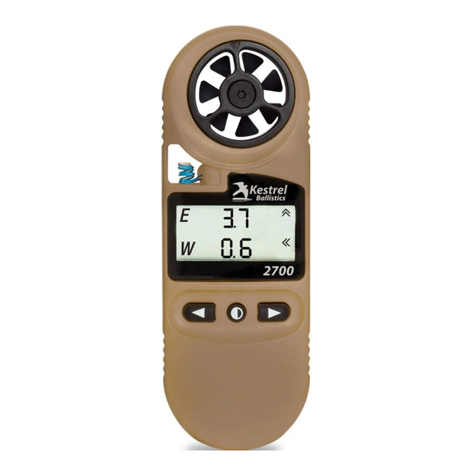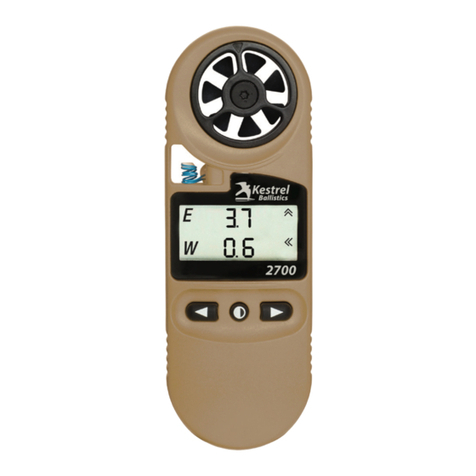
2
using the application is that there a library full of 4DOF bullet files which have been extensively
tested by Hornady and should provide the best results right out of the box. Below is information
if you wanted to build the gun on the Kestrel itself.
GUN – Create a gun name that will be identifiable to you when selecting the profile.
MV – Muzzle Velocity. If you have a calibrated chronograph, use it to measure your muzzle
velocity. If not, enter your best estimate. You can look for the manufacturer’s generic estimate
(based on average barrel length) on the ammo box or on the manufacturer’s website.
Compensations can be made later in this document to account for inexact muzzle velocity
entries.
DM/BF – Drag Model / Bullet File. This field is called drag model (DM) if using G1 or G7
standard drag models. However if you instead load a bullet file from the Kestrel LiNK Ballistics
app, this field becomes a bullet file and uses Hornady’s 4DOF Doppler modeling of the bullet.
BC – Bullet Coefficient. The ballistic coefficient is a ratio of how aerodynamic your bullet is
versus the drag model it is being compared against. BC values will be based on the G1 or G7
model. You can find these values on bullet manufacturer’s websites although if only 1 value is
given, it is typically for a G1 model. The Kestrel LiNK Ballistics bullet library also lists a majority
of these values if building a profile in the app. Please note: if using a bullet file, the BC will show
as “---“.
BW - Bullet Weight. Measured in grains or grams, this is usually given as part of the bullet’s
name. The bullet weight of a 180-grain 0.308 round is 180 grains.
BD – Bullet Diameter. Ensure you are using correct measurements, as the names of many
calibers are not accurate representations of the actual bullet diameter (i.e., 30 caliber rounds
are actually 0.308”, not 0.300”).
Rifle/Scope Data – In addition to Muzzle Velocity, additional information about your rifle and
scope are needed to calculate a ballistic solution.
ZR/ZA – Zero Range / Zero Angle. Zero Range is the distance at which your rifle was zeroed. If
the rifle is zeroed at longer ranges (200-300 yards) environmental changes cannot be ignored
which is why zeroing at shorter distances (100 y or 100 m) is recommended. If you highlight ZR
and press the center button, you can change this value to ZA (Zero Angle). Zero Angle on the
other hand is a measure of the angle between the straight line following the axis of the scope
and the straight line following the axis of the rifle barrel. This angle is very small and would be
difficult to measure directly but the 4DOF ballistics engine can find the angle when provided
with environmental data and bullet impact location. Once the solver knows the Zero Angle
between your rifle and scope a very accurate solution can be provided regardless of how long
the zero range is or how much the weather changes. It is recommended to follow the Cal Zero
Angle guide on the Kestrel to find the appropriate value for your rifle/scope.
BH – Bore Height. Also known as Scope Height, this is the distance from the center axis of the
scope to the center axis of the barrel. Measuring the vertical distance from the center of the

























